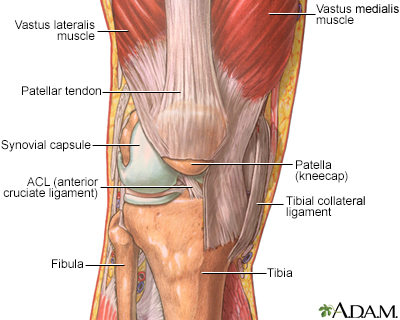Definition
Joint swelling is the buildup of fluid in the soft tissue surrounding the joint or the joint itself.
Considerations
Joint swelling may occur along with joint pain. The swelling may cause the joint to appear larger or abnormally shaped.
Joint swelling can cause pain or stiffness. After an injury, swelling of the joint may mean you have a broken bone or a tear in the muscle tendon or ligament.
Many different types of arthritis may cause swelling, redness, or warmth around the joint.
An infection in the joint can cause swelling, pain, and fever.
Causes
Joint swelling may be caused by different conditions, including:
Home Care
For joint swelling after an injury, apply ice packs to reduce pain and swelling. Raise the swollen joint so that it is higher than your heart, if possible. For example, if your ankle is swollen, lay down with pillows comfortably placed under your foot so that your ankle and leg are slightly raised.
If you have arthritis, follow your health care provider's treatment plan.
When to Contact a Medical Professional
Contact your provider right away if you have joint pain and swelling with a fever.
Also contact your provider if you have:
- Unexplained joint swelling
- Joint swelling after an injury
What to Expect at Your Office Visit
Your provider will examine you. The joint will be closely examined. You will be asked about your joint swelling, such as when it began, how long it has lasted, and whether you have it all the time or only at certain times. You may also be asked what you have tried at home to relieve the swelling.
Tests to diagnose the cause of joint swelling may include:
Physical therapy for muscle and joint rehabilitation may be recommended.
References
West SG. Systemic diseases in which arthritis is a feature. In: Goldman L, Schafer AI, eds. Goldman-Cecil Medicine. 26th ed. Philadelphia, PA: Elsevier; 2020:chap 259.
Woolf AD. History and physical examination. In: Hochberg MC, Gravallese EM, Silman AJ, Smolen JS, Weinblatt ME, Weisman MH, eds. Rheumatology. 7th ed. Philadelphia, PA: Elsevier; 2019:chap 32.
Van Vollenhoven RF. Evaluation of monoarticular and polyarticular arthritis. In: Firestein GS, Budd RC, Gabriel SE, Koretzky GA, McInnes IB, O'Dell JR, eds. Firestein & Kelley's Textbook of Rheumatology. 11th ed. Philadelphia, PA: Elsevier; 2021:chap 45.


